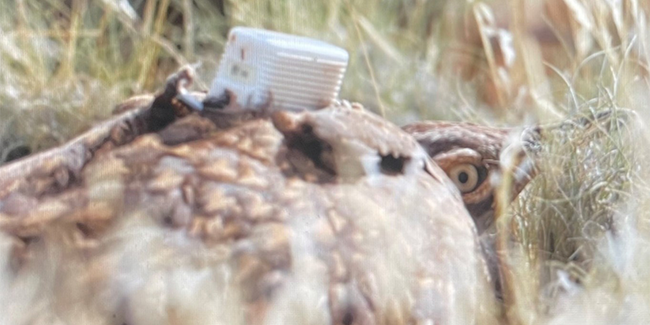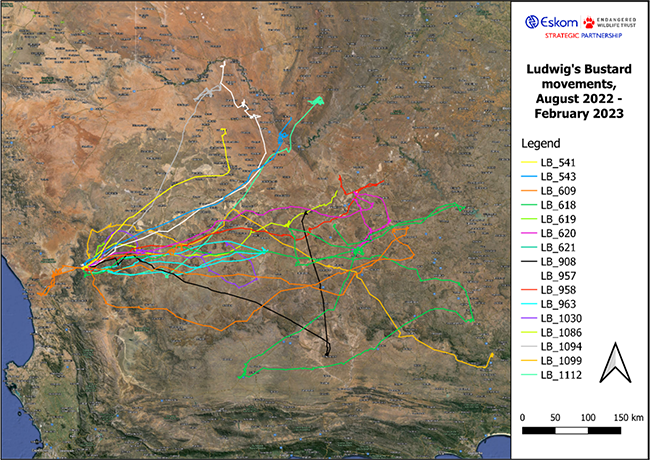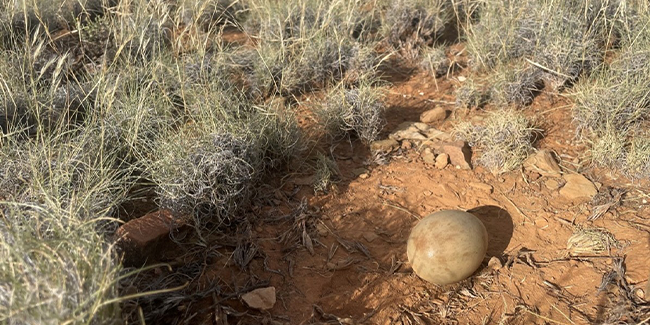Powerlines May Be A Cause Of Ludwig’s Bustard Population Declines

Figure 1: An incubating Ludwig’s Bustard female, fitted with a white GPS tracking device, sits tightly on her nest.
Collisions with overhead power line cables are thought to be the main driver of apparent population declines of the Ludwig’s Bustard (Neotis ludwigii).
Endangered Ludwig’s Bustard populations are assumed to be decreasing, with a more than 50% reduction expected over the next three generations.
At present, transmission line collision mortality rates of 1.12 bustards per kilometre per year are alarmingly high given the extent of these lines throughout their range. The species remains a research priority for the partnership between the Endangered Wildlife Trust and South Africa’s power utility, Eskom. The Partnership has found after a 10-year transmission line marking experiment that mitigation is ineffective for the Ludwig’s Bustard and for bustards in general.
Bustards are the one group of birds for which effective mitigation measures are yet to be demonstrated in southern Africa. Conservation options are limited to the further development and testing of new marker types and to burying overhead power line cables. A new power line marking experiment, for which four novel marker types are being tested, is showing some very positive results: no new Ludwig’s Bustard mortalities having been recorded since the marking of experimental sections of a transmission line in the Karoo in February 2022.
A well-informed estimate of the extent to which power line collisions affect the survival of the species is needed to justify significant future investment in conservation efforts. Such an estimate requires better information about Ludwig’s Bustard breeding biology, movement ecology and population dynamics. Some of the most basic parameters of these aspects have not yet been answered empirically, as the species is notoriously shy and difficult to study in the field. Luckily, advances in certain technologies present new tools that may enable us to fill these knowledge gaps.
To help us answer some of these questions, a Ludwig’s Bustard GPS-tracking study, the ‘Karoo Ludwig’s Bustard Project’, was initiated in 2022. Extensive trapping efforts resulted in a sample of 16 adult birds being captured and fitted with GPS trackers in the past two years. Our goal has been to focus on female birds to obtain information about their breeding parameters.
Since the first birds were captured in August 2022, we have been following up on GPS signals that may indicate nesting activity. This was unsuccessful until 2 February 2023 when one of the GPS-tagged females was found incubating a single large egg. The bird was well camouflaged and we only managed to detect her at a distance of less than three metres.
When she flushed from her nest, we were able to install a remote camera to monitor the nesting. We are now very eager to retrieve the camera to view the photographs captured in the field.
We hope to encounter more nesting attempts to collect the data required for a population viability analysis. Through this exercise we will hopefully be able to model the impact that power line collision mortalities have on the survival of the South African Ludwig’s Bustard population — information that will help direct the focus of our current and future research.

Figure 2: The movements of 16 GPS-tagged Ludwig’s Bustards, August 2022 – February 2024.

Figure 1: An incubating Ludwig’s Bustard female, fitted with a white GPS tracking device, sits tightly on her nest.
To help us answer some of these questions, a Ludwig’s Bustard GPS-tracking study, the ‘Karoo Ludwig’s Bustard Project’, was initiated in 2022. Extensive trapping efforts resulted in a sample of 16 adult birds being captured and fitted with GPS trackers in the past two years. Our goal has been to focus on female birds to obtain information about their breeding parameters.
Since the first birds were captured in August 2022, we have been following up on GPS signals that may indicate nesting activity. This was unsuccessful until 2 February 2023 when one of the GPS-tagged females was found incubating a single large egg. The bird was well camouflaged and we only managed to detect her at a distance of less than three metres.
When she flushed from her nest, we were able to install a remote camera to monitor the nesting. We are now very eager to retrieve the camera to view the photographs captured in the field.
We hope to encounter more nesting attempts to collect the data required for a population viability analysis. Through this exercise we will hopefully be able to model the impact that power line collision mortalities have on the survival of the South African Ludwig’s Bustard population — information that will help direct the focus of our current and future research.

Figure 3: A single, large Ludwig’s Bustard egg.
